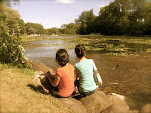很厚颜地贴明天的presentation稿,关于类书
清史课的。今天中午抱着电脑,凑着暖气和一杯茶写的。这几天看了一点点类书,有好多感慨,回头再补。。
Given the fact that leishu occupied almost 10% of the content in Siku 四庫, the genre provides extraordinarily rich material for researchers then and now. Hu Daojing defined leishu as comprehensive compilation of all branches of knowledge about human society and natural world, but this differs from the modern idea of "encyclopedia" (Baikequanshu百科全書) in that entries in leishu were quotes and excerpts from primary material instead of a separately-composed essay. In a sense, leishu could be understood as a hybrid of encyclopedia essays and compiled information.
The broad scale of Leishu creates difficulty for bibliographers in deciding the place of this genre in the tree of knowledge. Since texts from all the traditional divisions of writing (Jing 經/Shi 史/, zi 子/ji 集 i.e., Classics/ Histories/ Philosophers/ Belles-lettres) could all be found within the pages of a Leishu, where should Leishu go? The Siku compilers were aware of this problem, but nonetheless followed convention and kept Leishu in the Zi category.
When using a particular leishu, it is important to note its origin, its intended readership, and its scope of content. Aside from the imperially funded leishu projects, there is also a considerable body of leishu titles compiled by individual literati and printing houses. Official leishu such as Gujin tushu jicheng 古今圖書集成 signified the imperial court's support of scholarly endeavor and its authority over knowledge production, while at the same time providing useful guidance for officials in composing memorials and reports.
The wide circulation of practical leishu in all literate social strata, however, merits closer attention. Researchers have noted that the booming market for phonology leishu in the early Tang was closely related to the widespread practice of poetry-writing at the time, and that leishu also figured prominently in helping aspiring civil service exam-takers to prepare. In the Ming and Qing, vernacular leishu titles were sold, bought, and re-issued by printing houses. They offered popular guidance in coping with everyday life.
Bibliography:
Hu Daojing, Zhongguo gudai de leishu. Beijing Shi : Zhonghua shu ju, 2005.
Tang Guangrong, Tang dai lei shu yu wen xue. Chengdu Shi : Ba Shu shu she, 2008.
Liu Tianzhen, Ming dai tong su lei shu yan jiu. Jinan : Qi Lu shu she, 2006.
Labels: History_China before 1840


3 Comments:
恩,清晰,你一贯的文风:)
希望兔子能在丰富语言的同时保持文风朴实,平易近人,让不同领域的人都能接受:)
我觉得我的英文很朴实了啊。。@@
Post a Comment
Subscribe to Post Comments [Atom]
<< Home